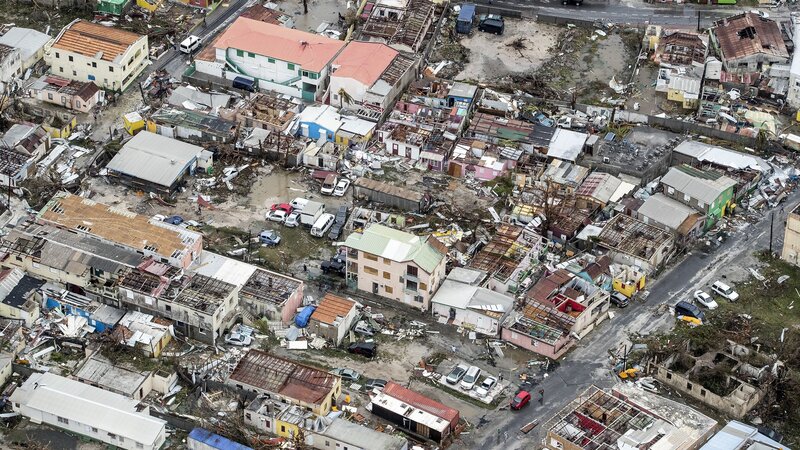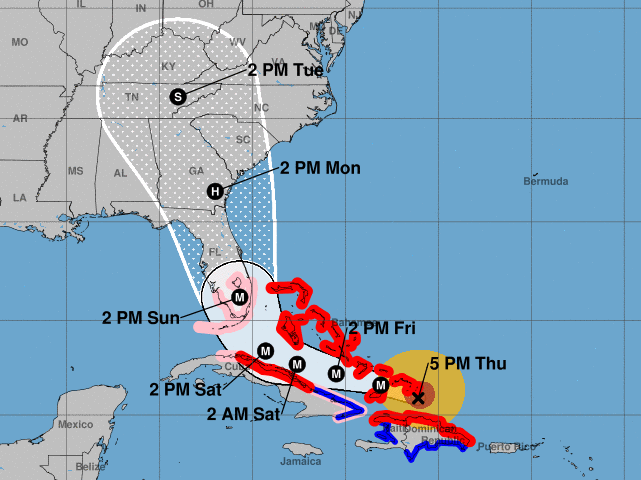Hurricane Irma Aims At Bahamas With 175-MPH Winds; Risk Rises For Florida
By Bill Chappell

Hurricane Irma Aims At Bahamas With 175-MPH Winds; Risk Rises For Florida
By Bill ChappellUpdated at 5 p.m. ET
Hurricane Irma is bringing death and destruction to the Caribbean and raising alarm in Florida and other Southern states, where the chance of a direct impact continues to rise. The storm is blamed for at least eight deaths; thousands of people are being told to get out of its way.
The large Category 5 storm has weakened somewhat but is still “extremely dangerous,” the National Hurricane Center says, reporting 175-mph maximum sustained winds in its 5 p.m. ET advisory on Thursday.
A hurricane watch is now in effect for parts of Florida, from Jupiter Inlet (north of West Palm Beach) south around the peninsula to Bonita Beach (south of Fort Myers). A watch means hurricane conditions are possible within 48 hours. The alert also covers the Florida Keys, Lake Okeechobee and Florida Bay.
“Based on what we know now,” Gov. Rick Scott said on Thursday afternoon, “Florida will have major hurricane impacts with deadly storm surge and life-threatening winds, and we can expect this all along the eastern coast of Florida.”
Scott said a storm surge of 5 to 10 feet is expected in several places, though he cautioned that much of the state could feel at least some of Irma’s effects, noting that the vast sweep of the storm — extending tropical-storm-force winds up to 185 miles from its center — is currently wider than the Florida Peninsula.
That threat also runs far to the north, according to the NHC: “The chance of direct impacts is increasing in portions of Georgia, South Carolina, and North Carolina, but it is too early to specify the magnitude and location of the impacts.”
Still, leaders in those states aren’t waiting to make a move. Gov. Henry McMaster has already declared a state of emergency in South Carolina, while Gov. Nathan Deal has declared a state of emergency in 30 counties in Georgia.
Under the latest forecast models, Irma would approach the coasts of those states on Monday morning still as a major hurricane.
Irma’s destructive path through the Caribbean
After passing north of Puerto Rico, Irma is following the same angle past Hispaniola, the island that is home to the Dominican Republic and Haiti. As of 2 p.m. ET, its eye was about 65 miles north-northeast of Puerto Plata, close to the center of the island’s northern coast. It’s now on a path that takes it toward the Bahamas, Cuba and the Turks and Caicos islands.
Irma brought strong winds and flooding to Puerto Rico and the Virgin Islands on Wednesday night. Its dangerous eye passed north of Puerto Rico’s main island — possibly sparing the area from the worst of the 185-mph winds that wreaked destruction in St. Martin, Anguilla and Barbuda on Wednesday.
Hurricane #Irma (left) and #Jose (right). Jose has its sights set on the #LeewardIslands, which were ravaged by Irma a few days ago. #GOES16 pic.twitter.com/SSYIAK7Vg8
— NASA SPoRT (@NASA_SPoRT) September 7, 2017
Things could get worse: On Thursday evening the NHC upgraded Hurricane Jose, which is now trailing behind Irma, to Category 3 — making it the third major hurricane of the 2017 Atlantic season. A hurricane watch was issued for Antigua and Barbuda and other islands.
“We are in a state of siege,” Daniel Gibbs, president of the Territorial Council of St. Martin, tells Radio Caraibes International.
Gibbs said that “95 percent of the territory has been destroyed,” echoing the assessment of Antigua and Barbuda Prime Minister Gaston Browne, who told CNN that Barbuda is now “barely habitable” after Irma’s eye hit the island early Wednesday.

In the U.S. Virgin Islands, at least three deaths have been confirmed on St. Thomas, and Gov. Kenneth Mapp is conducting an overflight of that island and neighboring St. John to assess damage, the government says. Mapp has also requested a major disaster declaration.
A hospital in St. Thomas was “heavily damaged” by Irma, the government of the U.S. Virgin Islands says. The most critically ill patients are being sent to St. Croix (which lies some 40 miles to the south) aboard military planes, while others are being taken to Puerto Rico.
As medical centers on St. Thomas dealt with damage and outages , two doctors set up a triage center at the Ritz-Carlton Hotel, the government said in a midday status update.
The last 4 days of Hurricane #Irma‘s eye as seen by the #GOES16 Advanced Baseline Imager. pic.twitter.com/ppht5XoiSe
— NASA SPoRT (@NASA_SPoRT) September 7, 2017
Floodwaters swamped cars and houses in Puerto Rico, where seven rivers are now running above their flood levels, according to the National Weather Service office in San Juan, capital of the U.S. territory.
Cellphone problems and power outages have also hit Puerto Rico, with more than 1 million people — roughly 70 percent of the electricity utility’s customers — lacking power due to the storm, local news agencies report.
Some 40 patients are being flown from St. Thomas to hospitals in Puerto Rico, the news site Primera Hora reports, adding that although in Puerto Rico “all hospitals are operating normally, 30 of them have no power, so they depend on electric generators.”
The human toll and damages from Irma are still being realized, partly because of the wreckage and debris the hurricane has left in its wake and partly because of communications networks being brought down by powerful winds and flying debris.
At least four people were killed and dozens wounded in Saint Martin, French officials said Thursday (earlier, Interior Minister Gerard Collomb said eight had died). The island is divided between French and Dutch administrations.
On Barbuda, a toddler died during the storm, Prime Minister of Antigua and Barbuda Gaston Browne told ABS TV/Radio Thursday.
There are reports of at least two more deaths — one in Anguilla and another in Puerto Rico, where local media relay a police report that an elderly woman died while being moved to a storm shelter. Those deaths have not been confirmed.
The hurricane is now moving west-northwest at 16 mph. It’s expected to move near or over the Turks and Caicos and parts of the Bahamas and later Thursday, likely hitting parts of Cuba on Friday.
Where Irma goes from here
Irma’s path is now projected to pivot north as it nears Florida. The timing of that turn is crucial to millions of people in the state, many of whom live in places already under mandatory evacuation orders. Those orders took effect in Key West on Wednesday; they now also cover barrier islands, including Miami Beach.

Miami-Dade County Mayor Carlos Gimenez’s order now covers about 650,000 people, out of the 2.7 million in the county.
There has been a run on gasoline, water and batteries, NPR’s Greg Allen reports. And while not everyone plans to leave, “the spectacle of what happened to Houston after Harvey, and the memories of Wilma in 2005 and Andrew 25 years ago, in 1992, are really on everyone’s minds. I’ve heard many people talk about Andrew.”
In downtown Miami, Greg adds, officials who are preparing for Irma are worried about more than 20 tall construction cranes, especially ones that tower over residential areas.
“They’re designed just to withstand winds up to 145 mph,” Greg says. “But right now, Irma’s winds are far higher … so a city official warned residents who live nearby those cranes to maybe think about leaving their buildings.”
Irma has slightly weakened — its sustained winds have been falling Thursday — but it’s likely to remain a Category 5 storm for at least 24 hours, the National Hurricane Center says.
Tropical-storm-force winds will arrive in southern Florida and the Keys on Saturday, the hurricane center predicts.
Those who choose to stay in the Keys will largely have to fend for themselves. The National Weather Service says all Coast Guard search-and-rescue vessels have left the area and the Port of Key West is closing Friday morning.
“This is not a storm you can sit and wait through,” Gov. Rick Scott warned Floridians on Thursday.
Absolutely uncanny copy-paste from 7 years ago. Very bizarre. #Irma #Jose #Katia #Igor #Julia #Karl pic.twitter.com/SHzo0BbZdq
— Brian McNoldy (@BMcNoldy) September 7, 2017
As Irma moves west in the Caribbean, its storm surge poses a dangerous threat. The Turks and Caicos and parts of the southeastern and central Bahamas could see from 15 to 20 feet of coastal water above normal levels. Cuba’s northern coast could get a surge of 5 to 10 feet.
After maintaining 185-mph winds, a tight eye and a well-organized system for more than 24 hours, the powerful storm finally showed a hint of weakness overnight, with the hurricane center saying at 5 a.m. Thursday that Irma had “become a little less organized” with clouds in its eye a central convection that was “somewhat ragged.”
As Irma brought havoc to the northern Leeward Islands on Wednesday and Thursday, two new hurricanes were christened in the Atlantic region: Jose, a storm that is tracking behind Irma, and Katia, which is off Mexico’s southern state of Veracruz.
Currently have 3 hurricanes w/ 2 major hurricanes in Atlantic - 4th time on record we’ve had 3 hurricanes w/ 2 majors at same time. #Irma pic.twitter.com/RNMsDMv09q
— Philip Klotzbach (@philklotzbach) September 7, 2017
Jose has gained strength and now has maximum sustained winds of 90 mph, the hurricane center says. The storm is projected to become a major hurricane Friday, and its winds are expected to top 125 mph over the next 36 hours before it begins to weaken.
As Jose moves west, it will take a more northward approach than Irma. But before it veers north of Puerto Rico, the hurricane could add to the miseries Irma brought to St. Martin, Barbuda and other areas. Jose is predicted to remain a major hurricane (meaning its winds are at least 111 mph) when it nears those islands early Saturday.
In the Gulf of Mexico, the National Hurricane Center says Katia is heading west-southwest and likely make landfall on Mexico’s coast late Friday or early Saturday.
Copyright 2017 NPR. To see more, visit http://www.npr.org/.
9(MDI4ODU1ODA1MDE0ODA3MTMyMDY2MTJiNQ000))
